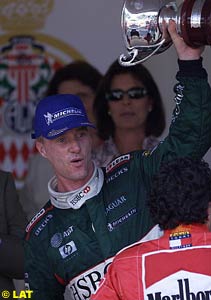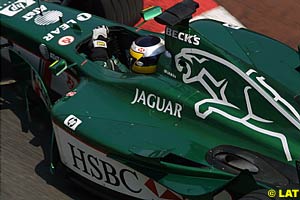
This week's Grapevine brings you |
As they head to Montreal, Jaguar are looking for Irvine to put together a similar weekend to Monaco, to prove the work of the last three months is worthwhile – and restore morale.
When news of Newey's pending arrival became known in the factory, on the back of the Monaco result, team morale reached an all time high. The change in attitude was immediately obvious, as was the result of McLaren's assertion that Newey would remain in Woking... the difference in output between the few days following Monaco and the rest of the season has demonstrated how low team morale has been allowed to get over the course of the year. Bobby Rahal has had clear warnings that failing to recover the situation is going to see key staff moving on.
At Monaco, Pedro de la Rosa, backed by Jackie Stewart, believed the biggest improvement to Jaguar's fortune was Eddie Irvine stepping his game up a gear, rather than the new aerodynamic solution. The extra downforce was useful, but from his perspective, nothing like the step forward Irvine felt it to be. The biggest impact from the changes were improved efficiency of airflow under the car, gaining three percent increase in downforce – reflected in de la Rosa's times by an improvement of around three tenths of a second around Monaco. Irvine's laps appeared to give him over half a second improvement.
Should that be carried to Canada, Jaguar can look to qualify in the top ten, keeping BAR, Jordan and Sauber honest. More than that, there is a real chance of points, if any more front runners have a bad day – and that would certainly go a long way to restoring morale.
The FIA are now coming under pressure from multiple fronts, following the mess over Adrian Newey’s being fumbled by both Jaguar and McLaren, the rejection of the BAR appeal, and banning the Arrows wing on safety grounds.
Frank Williams, on the other hand, believes contract recognition is a vital element of the future of Formula One, in order to protect the intellectual property of the teams. Most team members, on leaving, take some knowledge with them, which they use to good effect in their role with a new team. However, the three to five top designers are involved in practically all elements of the design and manufacture of cars, including long term strategy, and offshoot research and development elements. Without this involvement, they are far less effective at fulfilling their role; however, the exposure makes them prime targets for rival teams. And paying for a designer to spend the best part of a year on "gardening leave" is a very expensive pastime.
The BAR appeal has not really made headlines outside the paddock, and there's little apparent reason for it to do so. The FIA are famous for rejecting appeals, and none expected that to change: especially as the appeal was seen to be down to petty sportsmanship in the first place, offering tit-for-tat reprisals to a Sauber protest in Australia. However, there is some concern amongst the drivers: Raikkonen did, in fact pass Burti "under yellows." It took place around the point where the race restarted, with Burti slowing and moving aside to facilitate the manoeuvre... so the stewards classified it legal.
In doing so, a new grey line appeared in the rules, which by precedent, would appear to be interpreted as "do not pass under yellow flags, unless the car in front lets you." Where is the line to be drawn? If the car in front moves offline and travels slowly, are they asking you to pass, or just economising on fuel? The drivers are looking for clarification, before things get messy, but they are not expecting the FIA to provide it.
Lastly, a recurring theme, with the Arrows front wing being banned on "safety grounds," after passing the FIA crash test. That the nose was put through the official test program alone demonstrates that the FIA knew of its existence, and there is no doubt that they were anticipating its use at Monaco. It was banned after Thursday practice – following the well publicised route of the McLaren "third pedal" of 1998, "tower wings," Williams "outside the spirit of the law" diffuser and many other devices built in co-ordination with the scrutineers.
As teams continue to invest significant sums on developing new, legal, solutions, in conjunction with the FIA, only to see them banned, they are becoming increasingly disillusioned with the whole acceptance process. The FIA will always remain as the governing body of the sport, but as their influence is seen more and more to be interference, rather than governance, the teams are becoming restless...
For most of the teams in Formula One, Monaco is the place to bring current and prospective sponsors, giving them time to revel in the glitz and glamour of the sport's brightest social scene. As a rule, most of the top deals are made or left in disarray by the end of the weekend, and budget plans for the following year start to be drawn up.
However, the key technical partners are generally not involved at this stage: their commitments are arranged in private, at team's headquarters, where prying eyes can be kept to a minimum. The contributions by these players is often well guarded, and the teams repay technical expertise with good branding and product association. And this is most true of all for the team's oil and fuel suppliers.
However, the word in the paddock, is that Jaguar are wooing BP, whose subsidiary, Castrol, is a technical partner at Williams. Castrol's expertise is leveraged for the BMW engine oil, and widely recognised in the paddock for being very effective: indeed, tuning a modern engine includes putting in precisely the right lubrication to keep things ticking over smoothly. In a separate deal, Williams also use Petrobras, whose fuel is a big factor in the power of the BMW engine, and of necessity, there is information cross-flow between the two as they work to optimise the BMW unit.
Of course, BP going to Jaguar presents a big problem for the Grove outfit: whether or not the Castrol contract is terminated. The oil company holds a tremendous amount of the fuel knowledge built up through Petrobras, and can take this with them to Jaguar. Even without considering the boost it would give to Cosworth, BMW and Williams would need to establish a new oil supplier with a good development budget; their engine program would be severely compromised.
Of course, that leaves Williams little option but to also try for the attention of BP, jeopardising their long term relationship with Petrobras. Should BP become involved in Formula One, then fuel supply would be as critical to their role as oil, and they would look to be the complete petrochemical solution for a team. As you might guess, Williams are not finding it easy to explain their BP interests to Petrobras...
![]() Jaguar getting it together
Jaguar getting it together
 The Jaguar podium has proved a massive boost to team morale, but the Newey roller-coaster has been immensely disruptive, whilst testing at Magny Cours has been inconclusive proof of progress… Williams have been trying new Michelin rubber, and setting stunning times, leaving Jaguar to try and judge progress against the middle order Bridgestone runners.
The Jaguar podium has proved a massive boost to team morale, but the Newey roller-coaster has been immensely disruptive, whilst testing at Magny Cours has been inconclusive proof of progress… Williams have been trying new Michelin rubber, and setting stunning times, leaving Jaguar to try and judge progress against the middle order Bridgestone runners.
![]() FIA Under Pressure
FIA Under Pressure
 Following Gustav Brunner's high profile hijacking from Minardi by Toyata, Paul Stoddart called immediately for a contract recognition board to be set up, in order to protect a team from losing their leading designers to "unethical" poaching. The idea was mooted at that Austrian Grand Prix, but apparently without resolution: Tom Walkinshaw, at least, was opposed to the idea, and quite happy to say so.
Following Gustav Brunner's high profile hijacking from Minardi by Toyata, Paul Stoddart called immediately for a contract recognition board to be set up, in order to protect a team from losing their leading designers to "unethical" poaching. The idea was mooted at that Austrian Grand Prix, but apparently without resolution: Tom Walkinshaw, at least, was opposed to the idea, and quite happy to say so.
![]() Going for the Money
Going for the Money
 In the normal run of things, this provides the chance to renew ties with headline sponsors, finalising the sums to be spent on sponsor contract renewals and the exposure to be generated in return. On a good weekend, the front runners can expect to have over 90% of their budgeted sponsor income decided.
In the normal run of things, this provides the chance to renew ties with headline sponsors, finalising the sums to be spent on sponsor contract renewals and the exposure to be generated in return. On a good weekend, the front runners can expect to have over 90% of their budgeted sponsor income decided.
Please Contact Us for permission to republish this or any other material from Atlas F1.
|
Volume 7, Issue 23
Atlas F1 Special
Jean Alesi's New Start
Team Connaught: Remembrance of Things Fast
The Newey Saga
Why It Really Matters
The Point of Lauda
Canadian GP Preview
The Canadian GP Preview
Technical Preview: Montreal
Focus: Piquet in Canada
Columns
Elsewhere in Racing
The Canadian GP Quiz
Bookworm Critique
Rear View Mirror
The Weekly Grapevine
> Homepage |
